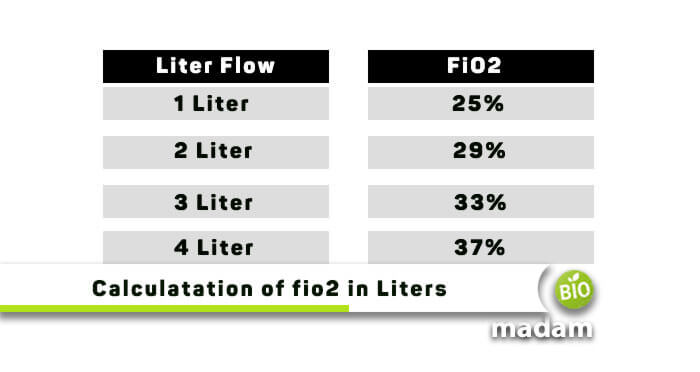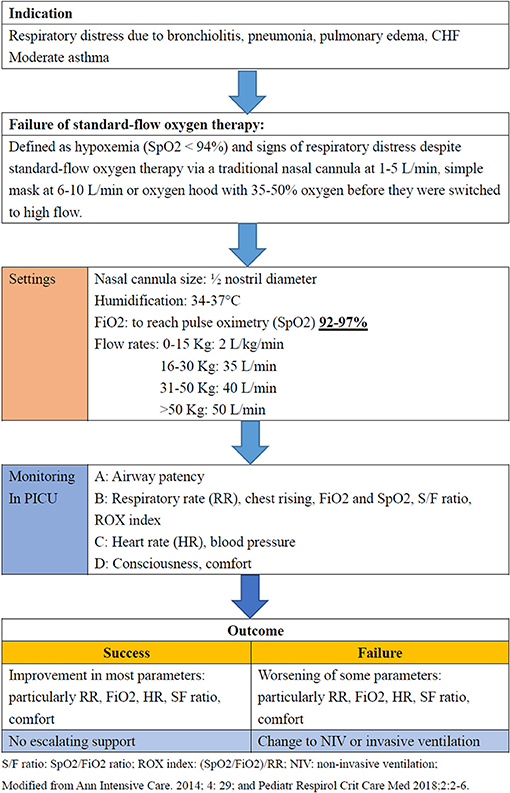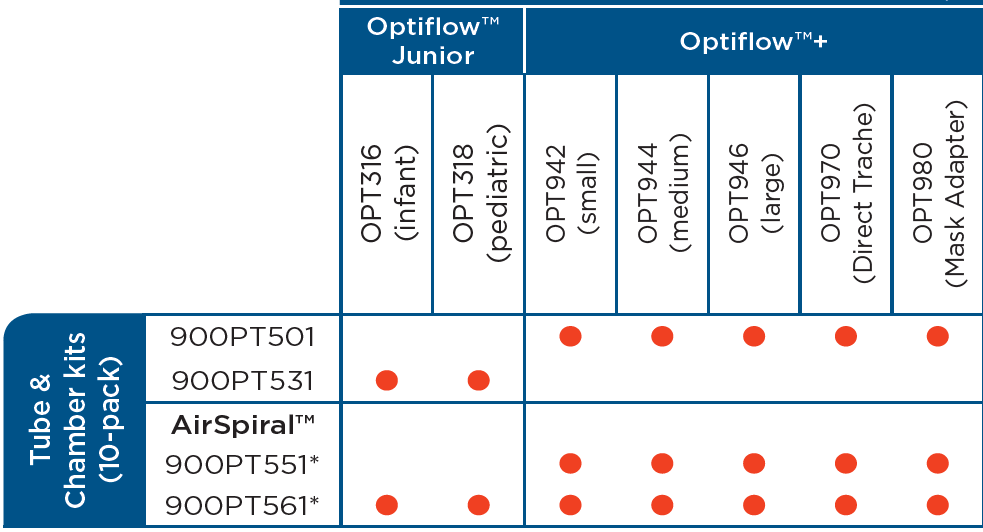high flow nasal cannula flow rate calculation
FiO 2 will then be titrated to the desired oxygen saturation. In adults it can be titrated from 20 L min up to 60 L min.

High Flow Nasal Cannula Influence Of Gas Type And Flow Rate On Airway Pressure And Co2 Clearance In Adult Nasal Airway Replicas Semantic Scholar
In pediatrics HFNC use continues to increase as the system is easily set up and is well tolerated by patients.

. PRP pressure rate product. To our knowledge there are few trials studying the effect of high-flow nasal cannula HFNC during deep sedation. Oxygen flow rate 5LPM from question Air flow rate 5 163 306 LPM NOT 5 x 163 835.
High Flow Nasal Cannula. A rule-of-thumb is to set the flow rate around 20-30 Lmin and titrate the flow to the patients respiratory rate and work of breathing. The nasal cannula is good for most patient needs with lower levels of oxygen requirements.
18 HFNC gas flows match the high spontaneous inspiratory flows generated by patients with shortness of breath reduce entrainment of room. Nasal prongs do not occlude the nare 50 of the nare is open Oxygenates airway dead space. RR EIT respiratory rate measured via electrical impedance tomography.
-- Air flow oxygen flow. High-flow nasal cannula HFNC therapy is an oxygen supply system capable of delivering up to 100 humidified and heated oxygen at a flow rate of up to 60 liters per minute. This gives more time for the process of intubation before desaturation happens.
Humidity and Temperature adjustable. Historically a non-rebreather mask NRM has been used to do this. Oxygen delivery through high-flow nasal cannulae increase end-expiratory lung volume and reduce respiratory rate in post-cardiac surgical patients.
ΔPes change in esophageal pressure. The gas is heated and humidified through an active heated humidifier and delivered via. Start the high flow nasal cannula system in room air ie.
Flow rate for HFNP Therapy is the same for all patients regardless of medical condition. Total flow 5 306 806 LPM To confirm your answer use the FiO 2 formula. See our table below for common estimates of FiO₂ based on oxygen delivery device and oxygen flow rates.
The positive end expiratory PEEP effect oxygenates the airway and the warm water creates vapors which loosens mucus so the alveoli can. We would obviously do this above room air 21. Once prescribed flow rate is reached assess requirement for supplemental oxygen.
The decisions to intubate a. By using specialized nasal cannulas heating the circuit to body temperature and humidifying the air these high rates can be delivered with very good patient tolerance. Heat and humidified high flow nasal cannula or as most call it Hi Flow Nasal Cannula HFNC isnt just a standard nasal cannula cranked up to very high flow rates.
ΔZ change in tidal impedance difference. HFNC high-flow nasal cannula. FIO2 titratable up to 100.
It actually takes gas and can heat it to 37 o C with a 100 relative humidity and can deliver 021 100 fi02 at flow rates of up to 60 litersmin. After HFNC during reassessment the ROX Index can help suggest which patients will fail HFNC and need to progress to intubation for further ventilatory support. The only exception to this rule is the first liter you add 3 consider this a favor done to get you onto numbers divisible by 4.
High-flow nasal cannula or HFNC is a system that allows oxygen to be delivered to patients at very high flow rates. Management of COVID 19 patients Huddle Sheet April 2020 High flow improves oxygenation for the patient by washing out dead space in the lungs and clearing out the CO2. The use of nasal cannula adapted to the infants nares size to deliver heated and humidified gas at high flow rates has been associated with improvements in washout of.
2017 discovered that in GOLD stage III and IV COPD patients high-flow nasal cannula at flow rates greater than 30 L per minute decreased the respiratory rate inspiratory time to total breath time ratio and diaphragmatic work of breathing compared to NIV. Patients in the NC group received oxygen at 2 L min 1 using a standard nasal cannula approximately corresponding to a FiO 2 of 030 15 whereas patients in the HF group received HFNO POINT high flow system Armstrong Medical applied immediately upon the arrival to the PACU with a flow rate of 40 L min 1 and a FiO 2 of 030. Nasal prongs should not completely occupy the nares.
Set FiO2 from 21 to 100. A higher index is better as it suggests a better oxygen saturation a lower. After initial treatment with nasopharyngeal suctioning and low-flow nasal cannula NC patients with persistent respiratory distress were transitioned to HFNC with a flow rate between 4 and 15 Lmin based on clinician assessment of patient work of breathing and F i O 2 between 40 and 100 adjusted to maintain saturations 90.
HFNC is humidified and delivered at body temperature to avoid cooling and desiccation of the nasal mucosa and most patients perceive this to be more comfortable than standard high-flow oxygen masks or NIV. Room Air 21. So this is how it goes.
An airoxygen blender allowing from 021 to 10 F I O 2 generates up to 60 Lmin flow. It takes gas is able to heat it to 37 o C with a 100 relative humidity and can deliver 021 - 100 fraction of inspired oxygen FiO 2 at flow rates of up to 60 liters Lmin. High-flow nasal cannula therapy can provide this in an alert awake patient by achieving a high-flow rate and very high amounts of FiO2 thus increasing PO2.
Set oxygen flow rate up to 8 Lmin on pediatric tubing up to 60Lmin in adults 10Kg 2 L per kg per minute max flow 60 Lmin start off at 6Lmin and increase up to goal flow rate over a few minutes to allow patient to adjust to high flow. For the most part just add 4 for each liter of O2. Our hypothesis is that high-flow nasal cannula HFNC will prevent hypoxemia and desaturation as compared to low-flow nasal cannula LFNC during prolonged deep sedation in patients with atrial fibrillation undergoing radiofrequency catheter.
HFNC has two parameters to be set by the providerflow rate and FiO 2. AU arbitrary unit. Nasal Cannula is typically started at 2Lmin and then titrated upwards to as high as 6Lmin although 2-4Lmin is ideal.
Principle setup of high-flow nasal cannula oxygen therapy. EELZ end-expiratory lung impedance. The flow rate and fi02 can be independently titrated.
Oxygen flow for every 1LPM of air flow. The calculation of nasal cannula FiO2 is rather easy. PesPEEP end-expiratory pressure measured via esophageal pressure.
In addition Dzira et al. Most HFNC circuits can deliver a maximum of 60 Lmin. High flow humidified oxygen delivered via nasal prongs longer than with standard Nasal Cannula Flow rates adjusted between 10-60 Litersminute.
The heat and humidified high-flow nasal cannula or as most call it high-flow nasal cannula HFNC isnt just a standard nasal cannula turned up to very high flow rates. High-flow nasal cannula HFNC is a relatively new device for respiratory support. All settings are controlled independently allowing for greater confidence in the delivery of supplemental oxygen as well as better outcomes when used.
This delivers 25-40 FIO2 depending upon their respiratory rate tidal volume and amount of mouth breathing.

Understanding Oxygen Lpm Flow Rates And Fio2 Percentages

How Does High Flow Nasal Cannula Hfnc Work Medmastery

Medical Math Calculating Oxygen Flow Rate Youtube

Pdf Delivered Oxygen Concentrations Using Low Flow And High Flow Nasal Cannulas

How To Calculate Fio2 From Liters Biomadam

Equation For Oxygen Delivery Download Scientific Diagram

Frontiers High Flow Nasal Cannula Therapy In Children With Acute Respiratory Distress With Hypoxia In A Pediatric Intensive Care Unit A Single Center Experience Pediatrics

All Ati Skills Module 3 0 Quizzes All Ati Dosage Calculation 3 0 Quizzes Answered 2022 In 2022 Dosage Calculations Airway Management Medication Administration

Air Entrainment Calculations Flashcards Quizlet

Hekaflo High Flow Nasal Oxygen Therapy Device Features Heka Medicals India Pvt Ltd

Student Nurse Goals Nursing Students Smart Specific Measurable Nurse

Effects Of Different High Flow Nasal Cannula Flow Rates On Swallowing Function Clinical Biomechanics

Equation For Oxygen Delivery Download Scientific Diagram

Clinical Guidelines Nursing Oxygen Delivery

Hekaflo High Flow Nasal Oxygen Therapy Device Features Heka Medicals India Pvt Ltd

Equation For Oxygen Delivery Download Scientific Diagram

Determining Iv Fluid Rates It S Important To Calculate The Right Amount Of Mivf Your Patient Should Be Getting Hourly To Prevent Iv Fluids Prevention Fluid
